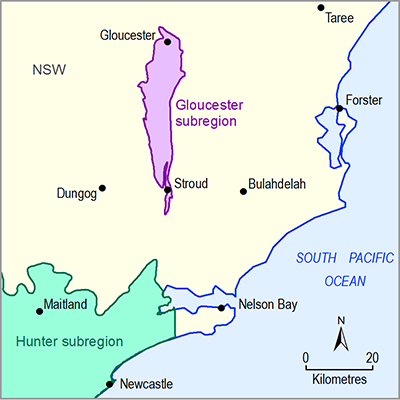Anderson DC and Nelson SM (2013) Floral ecology and insect visitation in riparian Tamarix sp. (saltcedar). Journal of Arid Environments 94, 105–112.
Commonwealth of Australia (2015) Draft national recovery plan for the regent honeyeater (Anthochaera phrygia), July 2015.
Dawes WR, Macfarlane C, McVicar TR, Wilkes PG, Rachakonda PK, Henderson BL, Ford JH, Hayes KR, O’Grady AP, Marvanek SP and Schmidt RK (2018) Conceptual modelling for the Gloucester subregion. Product 2.3 for the Gloucester subregion from the Northern Sydney Basin Bioregional Assessment. Department of the Environment and Energy, Bureau of Meteorology, CSIRO and Geoscience Australia, Australia. http://data.bioregionalassessments.gov.au/product/NSB/GLO/2.3.
DECC (2007) Private native forestry code of practice guideline no. 3 – Protocol for re-evaluating rainforest on private property. Viewed 5 December 2016, http://www.environment.nsw.gov.au/resources/pnf/prrainforest07371.pdf.
Eamus D, Froend R, Loomes R, Hose G and Murray B (2006) A functional methodology for determining the groundwater regime needed to maintain the health of groundwater-dependent vegetation. Australian Journal of Botany 54, 97–114.
Keith D (2004) Ocean shores to desert dunes: the native vegetation of New South Wales and the ACT. NSW Office of Environment and Heritage, Sydney.
Kuginis L, Byrne G, Serov P and Williams JP (2012) Risk assessment guidelines for groundwater dependent ecosystems, Volume 3 – Identification of high probability groundwater dependent ecosystems on the coastal plains of NSW and their ecological value. NSW Department of Primary Industries, Office of Water, Sydney.
Lunney D and Moon C (1997) Flying-foxes and their camps in the rainforest remnants of north-east NSW. In: Dargavel J (ed.) Australia’s ever-changing forests III. Centre for Resource and Environmental Studies, Australian National University, Canberra, 247–277.
McVicar TR, Langhi L, Barron OV, Rachakonda PK, Zhang YQ, Dawes WR, Macfarlane C, Holland KL, Wilkes PG, Raisbeck-Brown N, Marvanek SP, Li LT and Van Niel TG (2014) Context statement for the Gloucester subregion. Product 1.1 from the Northern Sydney Basin Bioregional Assessment. Department of the Environment, Bureau of Meteorology, CSIRO and Geoscience Australia, Australia. Viewed 5 December 2016, http://data.bioregionalassessments.gov.au/product/NSB/GLO/1.1.
McVicar TR, Macfarlane C, McNamara JM, Marston FM, Mount RE, Raisbeck-Brown N, Wang J, Moran BT, Moore B, Holland KL, Marvanek SP, Li LT, Zhang YQ and Barron OV (2015) Description of the water-dependent asset register for the Gloucester subregion. Product 1.3 for the Gloucester subregion from the Northern Sydney Basin Bioregional Assessment. Department of the Environment, Bureau of Meteorology, CSIRO and Geoscience Australia, Australia. Viewed 5 December 2016, http://data.bioregionalassessments.gov.au/product/NSB/GLO/1.3.
NSW Office of Environment and Heritage (n.d. a) Northern hinterland wet sclerophyll forests. NSW Government, Office of Environment and Heritage, Sydney. Viewed 5 August 2016, http://www.environment.nsw.gov.au/threatenedSpeciesApp/VegClass.aspx?vegclassname=Northern+Hinterland+Wet+Sclerophyll+Forests&habitat=C.
NSW Office of Environment and Heritage (n.d. b) Northern warm temperate rainforest. NSW Government, Office of Environment and Heritage, Sydney. Viewed 5 August 2016, http://www.environment.nsw.gov.au/threatenedSpeciesApp/VegClass.aspx?vegclassname=Northern+Warm+Temperate+Rainforests&habitat=C.
NSW Office of Environment and Heritage (n.d. c) Hunter-Macleay dry sclerophyll forests. NSW Government, Office of Environment and Heritage, Sydney. Viewed 5 August 2016, http://www.environment.nsw.gov.au/threatenedspeciesapp/VegClass.aspx?vegClassName=Hunter-Macleay+Dry+Sclerophyll+Forests.
NSW Office of Environment and Heritage (n.d. d) Wet sclerophyll forests (grassy sub-formation). NSW Government, Office of Environment and Heritage, Sydney. Viewed 5 August 2016, http://www.environment.nsw.gov.au/threatenedSpeciesApp/VegFormation.aspx?formationName=Wet+sclerophyll+forests+(grassy+sub-formation).
O'Grady AP, Carter J and Holland K (2010) Review of Australian groundwater discharge studies of terrestrial systems. CSIRO Water for a Healthy Country, Canberra.
Saunders DL and Tzaros CL (2011) National recovery plan for the swift parrot Lathamus discolour. Birds Australia, Melbourne.
Sommer B and Froend R (2010) Gnangara Mound ecohydrological study (RFT 0037-2008). Report to the Department of Water. Report no. CEM 2010-06. Centre for Ecosystem Management, Edith Cowan University, Joondalup.
Summerell GK and Mitchell M (2011) Terrain modelling to derive a groundwater surface for NSW upland areas using the SRTM-S adaptively smoothed vegetation offset DEM. 19th International Congress on Modelling and Simulation, Perth, Australia, 12–16 December 2011.
Zencich SJ, Froend RH, Turner JV and Gailitis V (2002) Influence of groundwater depth on the seasonal sources of water accessed by Banksia tree species on a shallow, sandy coastal aquifer. Oecologia 131, 8–19.
Zolfaghar S, Villalobos-Vega R, Cleverly J, Zeppel M, Rumman R and Eamus D (2014) The influence of depth-to-groundwater on structure and productivity of Eucalyptus woodlands. Australian Journal of Botany 62, 428–437.

